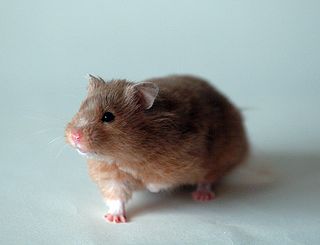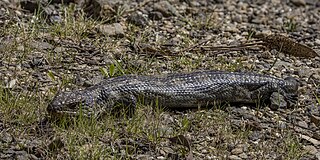
Skinks are lizards belonging to the family Scincidae, a family in the infraorder Scincomorpha. With more than 1,500 described species across 100 different taxonomic genera, the family Scincidae is one of the most diverse families of lizards. Skinks are characterized by their smaller legs in comparison to typical lizards and are found in different habitats except arctic and subarctic regions.

The Solomon Islands skink, also known as prehensile-tailed skink, monkey-tailed skink, giant skink, zebra skink, and monkey skink, is an arboreal species of skink endemic to the Solomon Islands archipelago. It is the largest known extant species of skink.

The pink-tongued skink is a species of lizard in the family Scincidae. It is endemic to Australia, where it is also called commonly the pink-tongued lizard. As suggested by these common names, its distinguishing characteristic is a pink tongue as opposed to the blue tongue of lizards of the closely related genus Tiliqua.

Anolis carolinensis or green anole is a tree-dwelling species of anole lizard native to the southeastern United States and introduced to islands in the Pacific and Caribbean. A small to medium-sized lizard, the green anole is a trunk-crown ecomorph and can change its color to several shades from brown to green.

The golden hamster or Syrian hamster is a rodent belonging to the hamster subfamily, Cricetinae. Their natural geographical range is in an arid region of northern Syria and southern Turkey. Their numbers have been declining in the wild due to a loss of habitat from agriculture and deliberate elimination by humans. Thus, wild golden hamsters are now considered endangered by the International Union for Conservation of Nature. However, captive breeding programs are well established, and captive-bred golden hamsters are often kept as small house pets. They are also used as scientific research animals.

Pygmy marmosets are two species of small New World monkeys in the genus Cebuella. They are native to rainforests of the western Amazon Basin in South America. These primates are notable for being the smallest monkeys in the world, at just over 100 g (3.5 oz). They are generally found in evergreen and river-edge forests and are gum-feeding specialists, or gummivores.

Blue-tongued skinks comprise the Australasian genus Tiliqua, which contains some of the largest members of the skink family (Scincidae). They are commonly called blue-tongued lizards or simply blue-tongues or blueys in Australia or panana in Indonesia. As suggested by these common names, a prominent characteristic of the genus is a large blue tongue that can be bared as bluff-warning to potential enemies. The type of predator/threat that is near will determine the intensity of colour present in the tongue. The tongue can also deform itself and produce a thick mucus in order to catch prey. They are relatively shy in comparison with other lizards, and also significantly slower due to their shorter legs.

The blotched blue-tongued lizard, also known as the southern blue-tongued lizard or blotched blue-tongued skink is a blue-tongued skink endemic to south-eastern Australia.

The threadfin rainbowfish or featherfin rainbowfish is a rainbowfish, the only species in the genus Iriatherina. It is characterized by long beautiful fins, and is among the most attractive of the rainbowfishes.

Tiliqua rugosa, most commonly known as the shingleback skink or bobtail lizard, is a short-tailed, slow-moving species of blue-tongued skink endemic to Australia. It is commonly known as the shingleback or sleepy lizard. Three of its four recognised subspecies are found in Western Australia, where the bobtail name is most frequently used. The fourth subspecies, T. rugosa asper, is the only one native to eastern Australia, where it goes by the common name of the eastern shingleback.

The Tiliqua scincoides scincoides, or eastern blue-tongued lizard, is native to Australia. Its blue tongue can be used to warn off predators. In addition to flashing its blue tongue, the skink hisses and puffs up its chest to assert dominance and appear bigger when in the presence of its predators such as large snakes and birds. The eastern blue tongue is ovoviviparous and precocial, meaning that its young are more developed and advanced at their time of birth. The Tiliqua scincoides scincoides is not venomous to humans and can be found in suburban and urban areas, specifically in house gardens.

The northern blue-tongued skink or northern blue-tongued lizard is the largest and heaviest of the blue-tongued lizards. They are native to Australia and found almost exclusively in the Northern Region. They generally live around 20 years and are commonly kept as pets.

The Adelaide pygmy blue-tongue skink or pygmy bluetongue is a species of skink, a lizard in the family Scincidae. The species was previously thought to be extinct and only rediscovered in 1992. Known locations of the species extend from Kapunda in the Light River valley, about 77 kilometres (48 mi) north east of Adelaide, northwards to Peterborough, about 254 kilometres (158 mi) north of Adelaide.

The red-fronted lorikeet, also known as the red-spotted lorikeet or red-rumped lorikeet is a species of parrot in the family Psittaculidae. It is found in northern New Guinea and the island of Biak. Its natural habitat is subtropical or tropical moist montane forests.

The fire skink, also known commonly as Fernand's skink, the Togo fire skink, and the true fire skink, is a fairly large skink, a species of lizard in the family Scincidae. The species is known for its bright and vivid coloration. Native to tropical forests in West and Central Africa, the fire skink lives fifteen to twenty years. This species is a diurnal lizard that burrows and hides. It is relatively shy and reclusive, but may become tame in captivity.

The Indonesian blue-tongued skink is a lizard in the family Scincidae. It is a close relative of the eastern blue-tongued lizard. They are endemic to the island of New Guinea and other various surrounding islands. They are found typically in the rainforest, and in captivity, require high humidity. In comparison to Tiliqua scincoides, they are fairly lean. They also have long tails.

Tiliqua scincoides is a species of skink. It is native to Australia as well Tanimbar Island.

The Centralian blue-tongued skink or Centralian blue-tongue is a species of skink, occurring predominantly in the far north-west corner of New South Wales, Australia. It is one of six species belonging to the genus Tiliqua; the blue-tongued skinks and the shinglebacks. This species of reptile classifies as a lizard.

The Merauke blue-tongued skink, also known as the faded blue-tongued skink, or giant blue-tongued skink, is a subspecies of Tiliqua that is native to Indonesia and Papua New Guinea. The Merauke blue-tongued skink is the longest of all the Tiliqua species; often reaching nearly 26-30 inches (66–76 cm) in total length. The species is often exported for the exotic pet trade, and is steadily growing in popularity within both herpetoculture and zoological exhibits globally.



















